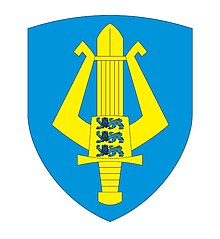Band of the Estonian Defence Forces
| Band of the Estonian Defence Forces | |
|---|---|
| Military Band | |
 | |
| Native name | Kaitseväe orkester |
| Short name | EKV orkester |
| Former name | Tallinn Garrison Band |
| Founded | 1 February 1993 |
| Location | Tallinn, Estonia |
| Principal conductor | Captain Simmu Vasar |
| Website | www |
The Kaitseväe orkester, known in Anglophone countries as the Band of the Estonian Defence Forces, is the official military band service of the Estonian Defence Forces. The main task of the band is to play music at all national and military ceremonies. The band's repertoire includes mostly classical and marching music. It is currently made up of 40 musicians. From 1996-2019, the conductor of the band was Lieutenant Colonel Peeter Saan.[1] Each year, the band takes part in about 220 concerts, festivals, and ceremonial parades of the Defence Forces. The band plays an important role in providing musical accompaniment for the annual independence day parade in Tallinn as well as providing accompaniment for state ceremonies. Traditionally, the band holds a autumn and spring concert in the Estonia Concert Hall.[2][3][4]
History

On November 24, 1918, the first independent Estonian military band was formed from the 1st Infantry Regiment of the newly formed Estonian Defense Forces. A few months later, the young band was subordinated to the Ministry of War and became the official military band of the ministry. The ministry then appointed Georg Reder to become the first director of music. In 1929, it was renamed to the Central Band of the Ministry of Defense and again in 1934 to the Tallinn Garrison Band The orchestra was dissolved during the Nazi Occupation of Estonia. After World War II, the Soviet government in Estonia replaced the orchestra with the massed bands of Tallinn Military Garrison under the Baltic Military District. Following the Fall of the Soviet Union, the band was officially reestablished on February 1, 1993 as the Central Band of the Defense Forces or the Kaitseväe Orkester. It would make its first appearance 3 weeks later at the Independence Day Parade on Freedom Square in Tallinn. Since 2014, the orchestra has been a member of the support army. Until then, the band was subordinated to the Northern Defense District.
Insignia
The active members and conscripts of the Defense Forces Band wear the field uniform and the band's emblem on the right shoulder of the band's blue uniform. Conductors and orchestra conductors of the Defense Forces Orchestra wear gold or orange double sheepskin trousers on their trousers. The orchestra wears three orange cross stripes on the regular six-sleeved elbow to cuff. The usual form of the orchestra also includes an axelbant, which is golden for conductors and orange for orchestra. The design of the usual form of the orchestra has been restored from the form of the Tallinn Garrison Orchestra, which has been in use since 1937. In addition to the regular and outdoor uniforms, the active servants of the band also wear a festive black evening uniform with a golden velvet band.
Conscripts
Each year, the Defense Forces Band recruits up to 20 conscripts after completing a shooting course (formerly SBK). The further career of conscripts consists of line drum training and performances with smaller ensembles (rock band, vocal ensemble). The repertoire of the conscript band is diverse, its arrangements include soldier songs as well as well-known hits by Estonian and foreign artists. The spring highlight of conscripts in recent years has been a performance at Veteranirock on Vabaduse Square in Tallinn. The main task of the band's conscripts is to popularize military service in the Defense Forces.
Commanders of the Kaitseväe orkester
- Captain Aivar Raigla (1993–1994)
- Lieutenant Colonel Indrek Toompere (1994–1996)
- Lieutenant Colonel Peeter Saan (1996–2019)
- Captain Simmu Vasar (2019–Present)
Notable ceremonial marches
| Title | Author |
|---|---|
| Mu isamaa, mu õnn ja rõõm | Fredrik Pacius |
| Pidulik signaal | N/A |
| Pidulik marss | Eero Liives |
| Eesti lipp | N/A |
| Võidu Teel | Rein Ploom |
| Hoia Jumal Eestit | N/A |
| Björneborgarnas marsch (Porilaste marss) | Unknown |
| Põhjalaagri marss | N/A |
| Politsei marss | Juri Maimik |
| Pidulik Eesti marss | Eduard Tamm |
| Homeland | Eero Liives |
| Festive March | Eero Liives |
| Military School March | August Arro |
See also
References
- ^ "Archived copy". Archived from the original on 2019-09-24. Retrieved 2020-06-26.
{{cite web}}: CS1 maint: archived copy as title (link) - ^ https://sputnik-news.ee/amp/event/20170317/5110823/kaitsevae-orkester-tahistab-oma-taasloomist-kevadkontserdiga.html
- ^ "Archived copy". Archived from the original on 2018-07-11. Retrieved 2018-05-05.
{{cite web}}: CS1 maint: archived copy as title (link) - ^ https://web.archive.org/web/20131122234412/http://www.mil.ee/et/kaitsevagi/maavagi/pohja-kaitseringkond/kaitsevae-orkester
- ^ https://www.sheetmusicplus.com/title/eesti-tseremoniaalmuusika-estonian-ceremonial-music-band-1-sheet-music/19265838
- ^ https://rateyourmusic.com/release/album/eesti_kaitsevae_orkester_eesti_rahvusmeeskoor_peeter_saan/eestimaa__mu_isamaa/
- ^ https://m.ee.sputniknews.ru/politics/20170905/7023340/sily-oborony-estonija-zashagajut-novyj-strojevoj-marsh.html?mobile_return=no
External links
- Official Website
- The Kaitseväe Orkester's discography
- Kaitseväe orkester - nende relvadeks on pillid
- The Kaitseväe Orkester performing "Pidulik marss", composed by Eero Liives
- Muusikapäev festival 2017 - October 1, 2017
- The orchestra at the Hamina Tattoo
- et:Peeter Saan the chief conductor and commander of the band.
- Pidulik marss on Estonian Wikipedia
